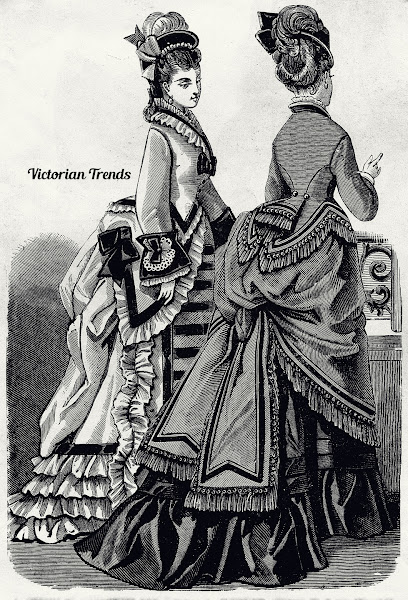A black and white fashion illustration from the May 1875 edition of
Frank Leslie's Lady's Magazine. The following is a description of the two costumes:
(Left)
Costume of light-brown silk alpace, trimmed with black Lyons silk. The front of the skirt is trimmed step-ladder fashion with bias silk bands, about one and a half inches wide, while the back breadths are encircled with four narrow overlapping flounces, headed with a similar silk band. These are framed with a ruche of the alpace, laid on in waves from waist to foot. The overskirt has the short pointed fronts, draped onto the long bouffant back-breadths by a bow of black ribbon, the points being edged with a narrow flounce and silk band. Close-fitting cuirass corsage, pointed front and back, and trimmed the same as the front of overskirt. The sleeves are coat-shaped, ornamented with a black silk cuff, on which is placed a black ribbon bow, encircled with lace. A band of the silk, edged with a down-falling flounce of the alpace and an upstanding frill of cambric decorates the neck, closed on the bust by a black ribbon bow. Black chip hat, trimmed with light brown and blue ribbons, and a blue feather.
(Right)
Promenade costume of black silk and French gray Summer cashmere. The silk skirt is trimmed with a gathered flounce, measuring in depth eight inches in front and twelve behind, surmounted with two wide and closely laid bands, piped on the edges. The overskirt and postilion basque are of the cashmere, edged with camels' hair fringe. The former is draped below the tournure, designing it as an apron, the looped sashes falling onto the silk flounce. Surmounting the fringe, on both the overskirt and basque, is a wide cashmere fold with a heavy
rouleau of black silk, laid on through the centre; and a flaring black silk collar, deeper behind than in front, completes the neck. Muslin ruff and undersleeves. Hat of French gray chip, trimmed with black ribbon, and two ostrich tips - rose pink and gray.

All digitized work by Victorian Trends.com is licensed under a
Creative Commons Attribution-NonCommercial 4.0 International License.
Free for personal use only. Please link back to VictorianTrends.com as your source when sharing or publishing.








